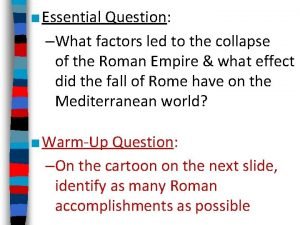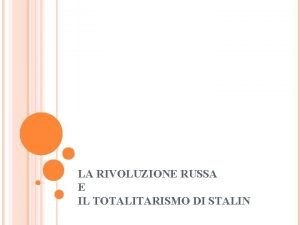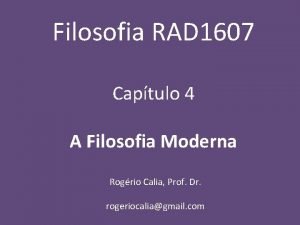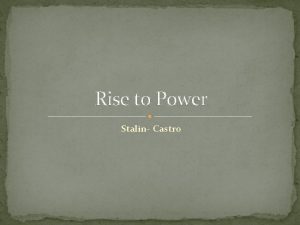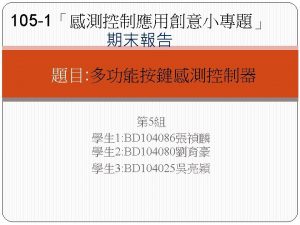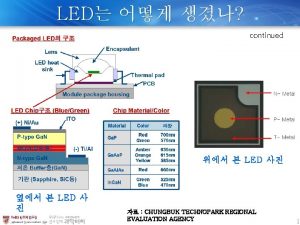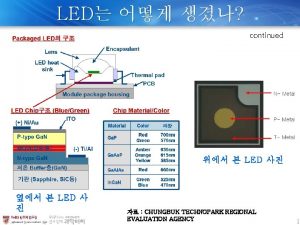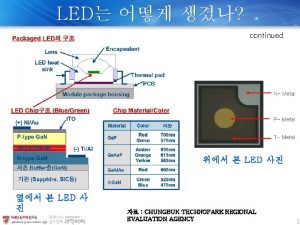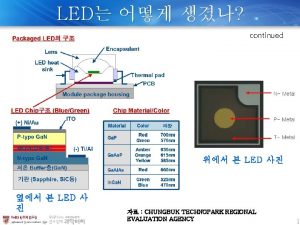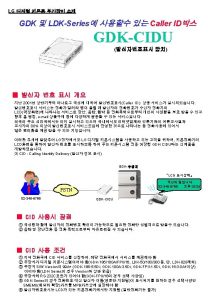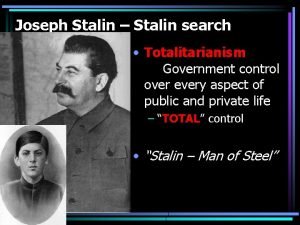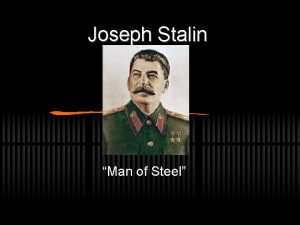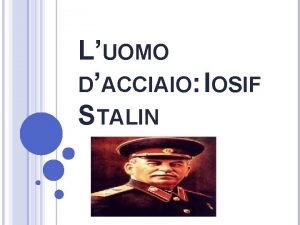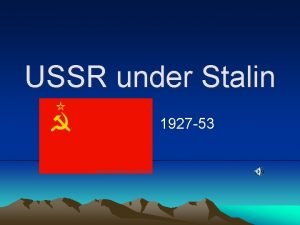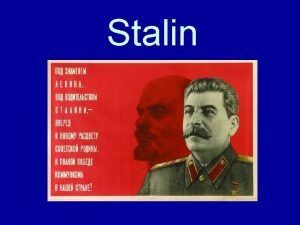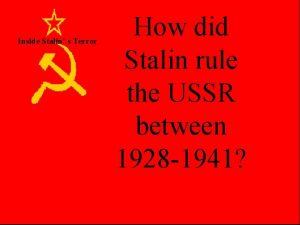1 WHAT LED TO THE RISE OF STALIN

















































- Slides: 49

1 WHAT LED TO THE RISE OF STALIN? Crisis and Conflict: Communist Russia Copyright 2006

2 Stalin’s Bid for Power Crisis and Conflict: Communist Russia Copyright 2006

The death of Lenin. Ø Lenin didn’t appoint a successor. l l Was he supposed to? In his Testament he damaged all the possible successors. Why? The power struggle began in 1922 after Lenin’s first stroke. The contenders were Stalin, Trotsky, Zinoviev, Kamenev, Bukharin, All members of the politburo.

4 JOSEPH STALIN Did not play significant role in the October Revolution or the Civil War. Ø Appointed Secretary-General of Communist Party in 1922 Ø Seen by Trotsky and many others as a dim-witted person Ø Stalin’s opponents underestimated him and did not consider him a serious threat Ø Crisis and Conflict: Communist Russia Copyright 2006

5 Stalin’s Positions Ø Since Lenin did not leave clear directions, the power was there for the taking and Stalin found himself well- placed. Ø Certain positions ( bureaucracy ) became crucial in creating “ connections and patronage “ Crisis and Conflict: Communist Russia Copyright 2006

6 Stalin’s Posts People’s Commissar for Nationalities ( 1917): Stalin was in charge of the officials in the many regions and republics that made up the USSR. Lenin judged that Stalin, as a Georgian, had a special; understanding of the national minorities. Ø Liaison Officer between the Politburo and Orgburo ( 1919): Stalin was in a unique position to monitor both the Party’s policy and the Party’s personnel. Ø Crisis and Conflict: Communist Russia Copyright 2006

7 Stalin’s Posts ( II ) Ø Head of the Workers’ and Peasants’ Inspectorate ( 1919) Stalin oversaw the work of all government departments. Ø General Secretary of the Communist Party ( 1922) : Stalin recorded and conveyed the Party Policy. This enabled him to build up dossiers on all the members of the Party. Nothing of note happened that Stalin did not know about. Crisis and Conflict: Communist Russia Copyright 2006

8 Patronage Ø The power of Patronage enables Stalin to place people in key positions. Ø Since they owed their place to him , Stalin could count on their support in the voting in the various committees Crisis and Conflict: Communist Russia Copyright 2006

9 RISE OF STALIN When Lenin died in January 1924, there was a struggle to replace him as leader of the Soviet Union. Ø Stalin delivered an oration to display the continuity between Leninism and Stalinism Ø Crisis and Conflict: Communist Russia Copyright 2006

10 Again Ø Among the candidates were: l l Leon Trotsky Lev Kamenev Greg Zinoviev Joseph Stalin Crisis and Conflict: Communist Russia Copyright 2006

Overall, Why did Stalin Succeed Ø He was general secretary of the party’s central committee. l He exercised control over the party machinery Ø Put himself at the center of the cult of Lenin Ø Old dedicated proletarian party member Ø His theory of socialism in one country more appeal then Trotskys “permanent revolution. had

12 Crisis and Conflict: Communist Russia Copyright 2006

13 Crisis and Conflict: Communist Russia Copyright 2006

14 Crisis and Conflict: Communist Russia Copyright 2006

15 RISE OF STALIN Ø Trotsky was considered the front-runner. Ø In 1924, no one expected Stalin to become Lenin’s successor. Ø Yet by 1929, Stalin had managed to outwit all his rivals to become the leader of the Soviet Union. How did he do that? Crisis and Conflict: Communist Russia Copyright 2006

Quest for Power Ø Lev Kamenev and Gregory Zinoviev, who had been leading players in the 1917 Revolution, joined Stalin in an official triumvirate within the Politburo. Ø Their aim was to isolate Trotsky by exploiting his unpopularity with large sections of the Party.

17 LEON TROTSKY Ø Ø Ø Brilliant and fearless leader with great speaking and writing skills Played a leading role in the October 1917 Revolution Led the Red Army to victory during the Civil War Saw himself as Lenin’s rightful heir Seen as arrogant by his opponents Crisis and Conflict: Communist Russia Copyright 2006

Trotsky’s handicaps Trotsky was a Jew and very conscious of the fact that this constituted a political handicap. Anti-Semitism was an ingrained feature of Russian society and continued under communist rule. Ø In 1917 he had declined Lenin’s offer to be a commissar on the grounds that his appointment would be an embarrassment to Lenin and the government, he said it would give enemies grounds for claiming that the country was ruled by a Jew. Ø

Trotsky’s intellectualism, coupled with an aloof style and manner, gave him the appearance of an outsider who was not fully committed to the CPSU. This deprived him of a significant following in the Party. Ø CPSU members tended to regard Trotsky as dangerously ambitious and his rival Stalin as reliably self effacing. This was because Trotsky was flamboyant and brilliant, while his rival was unspectacular and methodical. Ø Trotsky had not become a Bolshevik until 1917, which raised doubts about how committed he was to the Party. Ø

20 How Soviet Union is ruled Ø One-party rule; no free elections Ø Party Congress brings together thousands of delegates from party organizations across the country. Its main function is to "elect" a Central Committee which runs the Communist Party. Ø In turn, the Central Committee's main job is to elect a Politburo which decides government policies. Crisis and Conflict: Communist Russia Copyright 2006

Stalin played on the tension within the Politburo Crisis and Conflict: Communist Russia Copyright 2006 21

22 Leftists vs Rightists Ø Main Issue : NEP Ø Leftists ( Bolshevik Party members who wanted NEP abandoned) Ø Rightists ( Bolshevik Party and CCP members who argued for a slower , less violent development of revolution and for the continuation of the NEP. Crisis and Conflict: Communist Russia Copyright 2006

Ideological Differences between Trotsky and Stalin Ø Ø Ø Trotsky was an international Marxist Central Belief is « Permanent Revolution was not a single event but a permanent ( continuous ) process in which risings took place from country to country. The events in Russia since 1917 were simply a first step towards a worldwide revolution of the proletariat. The USSR could not survive alone in a hostile world. It needed to “ export revolution”. Unless there was an international revolution, the USSR wont survive. Crisis and Conflict: Communist Russia Copyright 2006 23

24 Stalinism Ø Ø Ø Socialism in One Country Consolidation of Lenin’s Revolution Overcoming its present agricultural and industrial probl; ems by its own unaided efforts Proceeding to build a modern state , the equal of any nation in the world Survival of USSR is an absolute priority , even at the expense of the World Revolution ( exterminating the external and INTERNAL enemies of the state) Crisis and Conflict: Communist Russia Copyright 2006

25 Leftism Ø Trotskism then becomes a threat to the USSR security Ø Later on, anything « Trotsky » meant a threat to the USSR security Crisis and Conflict: Communist Russia Copyright 2006

Constitution of 1924 Ø Constitution of 1924: Ø Presidium Ø Executive central committee Ø All-Union Congress of soviets l Republican soviets • Provincial soviets l District soviets • Local soviets

27 Isolating Trotsky Stalin is using Presidium and Politburo and Social Committee ( people who received their positions through his patronage ) to SUPPORT his agenda therefore against Trotsky. Ø Trotsky’s failure to convince the Politburo was considered as propaganda against the security of USSR. Ø Following the vote of the Congress , he was removed from his position as Commissar for War. Ø Kamenev ( Chairman of Moscow Soviet ), Zinoviev ( Chairman of Leningrad Soviet ) ensured that the platform must be PRO-STALIN and ANTI- TROTSKY. Ø Crisis and Conflict: Communist Russia Copyright 2006

28 LEV KAMENEV Member of the Bolshevik Party since its formation in 1903. Ø Trusted by Lenin. Ø Ø Had good leadership and organisational skills. Ø Acted as Lenin’s deputy before. Ø Opposed Lenin on the timing of the October Revolution. Crisis and Conflict: Communist Russia Copyright 2006

29 GRIGORY ZINOVIEV Member of the Bolshevik Party since its formation in 1903. Ø Trusted by Lenin. Ø Had good leadership and organisational skills. Ø Also opposed Lenin on the timing of the October Revolution. Ø Crisis and Conflict: Communist Russia Copyright 2006

30 1925 Ø Ø Ø Slow economical growth « due to NEP « NEP needed to be stopped to implement « Modernization/ heavy industrialization » Since NEP was a Lenin’s creation , any opposition to it led to « factionalism « and opposing « the platform of the enlightened leader » Kamenev, Zinoviev, got into their own trap as they wanted to stop it to modernize and industrialize USSR, They also wanted to remove peasants’ concessions Crisis and Conflict: Communist Russia Copyright 2006

Left Opposition continued They were deemed « an opposition » , » the New Opposition » Ø Their voices resembled Trotskism and were outvoted by the Congress Ø Kamenev was removed and replaced by Molotov Ø Zynovyev was replaced by Kirov Ø Trotsky was removed from the Politburo and the Central Committee Ø Crisis and Conflict: Communist Russia Copyright 2006 31

32 Leftist 1925 Trotsky fought back ( his credo was that there was too much bureaucratization ) but you could not critique the Party( centralized democracy ) Ø 1927 Challenged Stalin openly for his authoritarian rule. As a result, he was expelled from the Party Ø 1929 Deported out of Russia( was not executed as Stalin was not in complete control yet ) Ø Crisis and Conflict: Communist Russia Copyright 2006

33 Rightists Alexei Rykov, Mikhail Tomsky, Nicolai Bukharin Ø Not as dangerous as left Ø Believed in a momentum of industrialization , not enforced collectivization and industrialization Ø They believed that by allowing the pesants to become prosperous , there would be more grain to SELL ABOROAD Ø 1928 Policy of state procurements was counterproductive ( enforced collections of grain from peasants ) Ø Crisis and Conflict: Communist Russia Copyright 2006

34 Stalin used « party vigilance and ruthless treatment of class struggle argument « Ø Ø Stalin preached « no concessions to the Peasants , a tough policy towards them ) Rights appeared weak and disloyal ( formation of factions) but hoped to persuade the Congress Their support came from Trade Unions( Nicolai Uglanov , one of them) but Stalin sends Kaganovich , a ruthlessly ambitious member of Politburo to arrest the suspect trade unionists Overall, Rightists’ 3 weaknesses : ideas, organization, lack of support Crisis and Conflict: Communist Russia Copyright 2006

35 Collapse of the Right Ø 1929, Tomsky lost his position as National Trade Union Leader Ø Rykov has been suspended as Premier ( Soviet Chairman of Council of Commissars ) Ø Bukharin lost his position in the Politburo. Ø The trio was allowed to stay in the Party Ø Had to accept the mistakes publicly Crisis and Conflict: Communist Russia Copyright 2006

36 Factors for rise of Stalin Non-disclosure of Lenin’s Testament (will) Ø Trotsky’s unpopularity in the Party Ø Stalin’s manipulations/ trickery l pretended to have been close to Lenin l control over party organization’ l exploitation of divisions l Becomes a new Vozgd Ø Crisis and Conflict: Communist Russia Copyright 2006

37 Crisis and Conflict: Communist Russia Copyright 2006

38 Non-disclosure of Lenin’s Testament (will) Ø Before his death, Lenin wrote a will expressing his views of various leaders of the Communist Party. Ø E. g. Lenin warned that Stalin should not be trusted to use his power wisely. He also said that Stalin was rude and impatient and should be removed as Secretary-General. On the other hand, he praised Trotsky as the most capable man in the Party. Crisis and Conflict: Communist Russia Copyright 2006

39 Non-disclosure of Lenin’s Testament (will) Ø However, the Party leaders felt that the will should not be made public as Lenin had criticized all of them. In addition, some Party members felt that Trotsky was a greater threat so they decided to ignore Lenin’s instruction to remove Stalin. Ø Thus, the Party’s decision to ignore Lenin’s will allowed Stalin to retain his position as Secretary-General of the Party, which he later used to great effect during his rise to power. (link to Stalin’s rise to power) Crisis and Conflict: Communist Russia Copyright 2006

40 Source 2. 3 (p. 38) “Comrade Stalin, having become Secretary-General, has unlimited authority concentrated in his hands and I am not sure whether he will always be capable of using that authority with sufficient caution. Stalin is too rude and this defect becomes intolerable in a Secretary-General. That is why I suggest that the comrades think about a way of removing Stalin from that post and appointing another man in his stead. ” Q) What does this source tell us about Stalin as a leader? Crisis and Conflict: Communist Russia Copyright 2006

41 “Comrades, every word of Lenin’s is law to us … But we are happy to say that in one point Lenin’s fears have proved baseless. I have in mind the point about Stalin. You have all witnessed our harmonious cooperation in the last few months; and like myself, you will be happy to say that Lenin’s fears have proved baseless. ” Zinoviev, one of Lenin’s closest associates, defended Stalin against Lenin’s call, in his will, for Stalin’s removal Crisis and Conflict: Communist Russia Copyright 2006

42 Trotsky’s unpopularity in the Party Ø Trotsky’s arrogance and extreme ideology made him an unpopular figure in the Communist Party. Ø E. g. Trotsky believed he would succeed Lenin and made little effort to build up any support within the ranks of the Party. He often offended other senior party and failed to take the opposition seriously. His support came from a narrow base: the youths, students and the Red Army. Crisis and Conflict: Communist Russia Copyright 2006

43 Trotsky’s unpopularity in the Party Ø Moreover, Trotsky’s idea of world revolution did not find broad acceptance among Party members because they were weary at the prospect of more fighting. In contrast, most Party members felt that Stalin’s idea of ‘Socialism in one country’ was more practical. Ø Thus, Trotsky’s unpopularity caused him to lose support within the party and weakened his quest for power. This paved the way for Stalin to take advantage and gain power at Trotsky’s expense. (link to Stalin’s rise) Crisis and Conflict: Communist Russia Copyright 2006

44 Stalin’s manipulation – pretended to have been close to Lenin Ø Stalin pretended that he had been close to Lenin to give others the impression that Lenin had favoured him. Ø E. g. when Lenin died in 1924, Stalin organized the funeral, gave the funeral speech and played the role of chief mourner, showing deep sorrow over Lenin’s death. Ba ck Crisis and Conflict: Communist Russia Copyright 2006

45 Stalin’s manipulation – pretended to have been close to Lenin Ø He also tricked his biggest rival, Trotsky, into missing Lenin’s funeral by giving him the wrong date. As a result, many party members were angry with Trotsky’s apparent lack of respect for Lenin when he failed to appear at the funeral. Ø Thus, through his political trickery, Stalin was able to present himself as the rightful successor to Lenin and destroy the reputation of Trotsky. This paved the way for his rise to power. (link to Stalin’s rise) Ba ck Crisis and Conflict: Communist Russia Copyright 2006

46 Stalin’s manipulation – control over Party organization Ø Stalin’s position as Secretary-General gave him considerable power over Party organization Ø E. g. Stalin appointed his own supporters to important posts and transferred supporters of his opponents to less important posts. Many key Party officials owed their positions to him and were loyal to him. Crisis and Conflict: Communist Russia Copyright 2006

47 Stalin’s manipulation – control over Party organization Ø By controlling the Party organization, Stalin was able to pack a 1925 Party meeting with his supporters, who voted to remove Trotsky from his posts. In 1927, Stalin had Trotsky expelled from the Party. Ø Thus, by controlling the Party organization, Stalin was able to build up his support base within the party which enabled him to consolidate his power and eliminate his opponents. (link to Stalin’s rise) Crisis and Conflict: Communist Russia Copyright 2006

48 Stalin’s manipulation – exploitation of divisions Ø Stalin took advantage of divisions within the Party and played one side against the other to gain power. Ø First, Stalin allied himself with Zinoviev and Kamenev to cover up Lenin’s Will and to get Trotsky dismissed. Ø Once Trotsky had been removed, Stalin then worked with Bukharin to relieve Kamanev and Zinoviev of their posts. Later, he had Bukharin removed from his post. Crisis and Conflict: Communist Russia Copyright 2006

49 Link to Stalin’s rise Ø Thus, by switching alliances and exploiting divisions within the party, Stalin was able to isolate his opponents and eliminate them one by one in a ruthless way. This paved the way for his rise to power. Crisis and Conflict: Communist Russia Copyright 2006
 What factors led to the decline of the roman republic
What factors led to the decline of the roman republic A union b example
A union b example Rise and rise again
Rise and rise again Tricky dick: the rise and fall and rise of richard m. nixon
Tricky dick: the rise and fall and rise of richard m. nixon Rise again and again until lambs
Rise again and again until lambs Tư thế ngồi viết
Tư thế ngồi viết Cái miệng bé xinh thế chỉ nói điều hay thôi
Cái miệng bé xinh thế chỉ nói điều hay thôi Các châu lục và đại dương trên thế giới
Các châu lục và đại dương trên thế giới Mật thư anh em như thể tay chân
Mật thư anh em như thể tay chân Bổ thể
Bổ thể Tư thế ngồi viết
Tư thế ngồi viết Thứ tự các dấu thăng giáng ở hóa biểu
Thứ tự các dấu thăng giáng ở hóa biểu Thẻ vin
Thẻ vin Thể thơ truyền thống
Thể thơ truyền thống Hát lên người ơi
Hát lên người ơi Sự nuôi và dạy con của hươu
Sự nuôi và dạy con của hươu Từ ngữ thể hiện lòng nhân hậu
Từ ngữ thể hiện lòng nhân hậu Diễn thế sinh thái là
Diễn thế sinh thái là Vẽ hình chiếu vuông góc của vật thể sau
Vẽ hình chiếu vuông góc của vật thể sau Làm thế nào để 102-1=99
Làm thế nào để 102-1=99 Tỉ lệ cơ thể trẻ em
Tỉ lệ cơ thể trẻ em Lời thề hippocrates
Lời thề hippocrates Vẽ hình chiếu đứng bằng cạnh của vật thể
Vẽ hình chiếu đứng bằng cạnh của vật thể đại từ thay thế
đại từ thay thế Quá trình desamine hóa có thể tạo ra
Quá trình desamine hóa có thể tạo ra Cong thức tính động năng
Cong thức tính động năng Môn thể thao bắt đầu bằng chữ f
Môn thể thao bắt đầu bằng chữ f Hát kết hợp bộ gõ cơ thể
Hát kết hợp bộ gõ cơ thể Sự nuôi và dạy con của hươu
Sự nuôi và dạy con của hươu Thế nào là mạng điện lắp đặt kiểu nổi
Thế nào là mạng điện lắp đặt kiểu nổi Các loại đột biến cấu trúc nhiễm sắc thể
Các loại đột biến cấu trúc nhiễm sắc thể Thế nào là sự mỏi cơ
Thế nào là sự mỏi cơ độ dài liên kết
độ dài liên kết Chó sói
Chó sói Thiếu nhi thế giới liên hoan
Thiếu nhi thế giới liên hoan điện thế nghỉ
điện thế nghỉ Một số thể thơ truyền thống
Một số thể thơ truyền thống Thế nào là hệ số cao nhất
Thế nào là hệ số cao nhất Trời xanh đây là của chúng ta thể thơ
Trời xanh đây là của chúng ta thể thơ Slidetodoc
Slidetodoc Hệ hô hấp
Hệ hô hấp Số nguyên là gì
Số nguyên là gì đặc điểm cơ thể của người tối cổ
đặc điểm cơ thể của người tối cổ Fecboak
Fecboak Các châu lục và đại dương trên thế giới
Các châu lục và đại dương trên thế giới Glasgow thang điểm
Glasgow thang điểm ưu thế lai là gì
ưu thế lai là gì La rivoluzione russa e il totalitarismo di stalin
La rivoluzione russa e il totalitarismo di stalin Stalin
Stalin Joseph stalin apush
Joseph stalin apush
